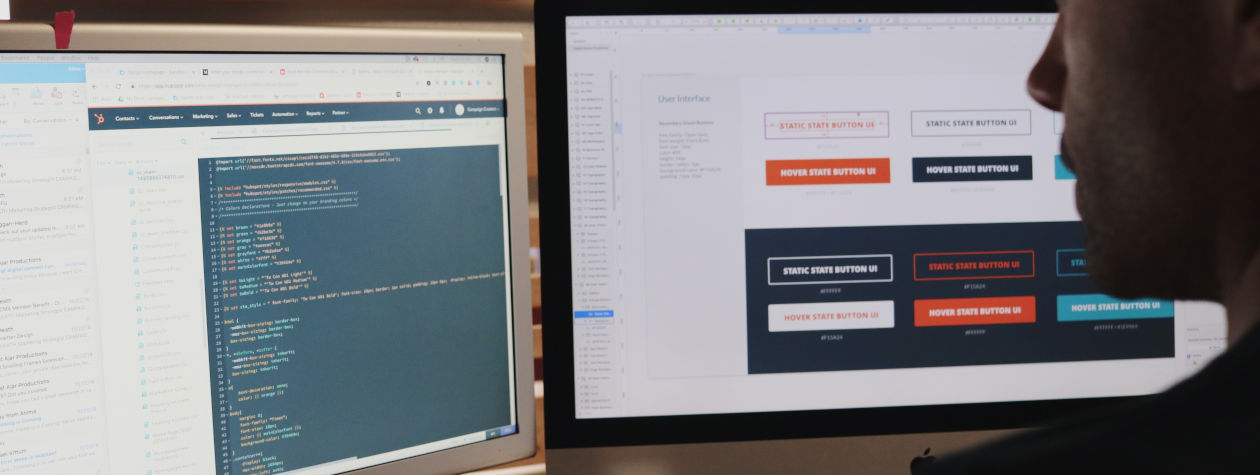Ask 100 ecommerce founders, and they’ll likely tell you to test email marketing. And while this is solid advice, you might need some pointers on using email marketing for ecommerce that drives more revenue.
Email marketing delivers a high return on investment. For every dollar you spend, you’ll make $40. Another reason I love this channel, email is a direct connection with your customer. It’s not subject to algorithm updates or at the mercy of another company.
A few things stop brands from using email marketing. You might feel comfortable posting on social media. You can post something in a few seconds. With email, there are plenty of moving parts that all require some thought.
You need an attractive layout, a catchy subject line, copy, and images. Not to mention finding a time and date that works for sending your email to the list. The task isn’t easy.
Some brands might have some of these elements already figured out. They’re waiting until they have a sizeable list to email. But there’s no need to wait, you can get going this week.
If you want to start using email marketing for your ecommerce store, this post will help you map out the path and get you ready to hit send!
What Is Ecommerce Email Marketing?
Email marketing involves sending targeted messages to people who’ve agreed to receive them. You can send emails to educate, promote, stay in touch, or ask for something such as a review or referral.
We love email is it’s a direct channel to your customer. You own the list. Meta (Facebook/Instagram/WhatsApp), Google, or Bing can’t restrict you from reaching people or force you to pay. There’s no fancy algorithm behind sending emails and no gatekeepers.
Despite the chatter on the internet, people still open and read emails, especially when given a compelling reason.

Why Use Email Marketing?
If you’re still not convinced that you should be investing in email marketing, here are my top 3 reasons to test this owned marketing channel.
Build ongoing customer relationships
Your customers still use email and will reply to them when prompted. So, it’s worth using this communication channel to build relationships and show you care.
The message matters more than how fancy it looks. Be a brand that cares and is willing to put in the work to build long-term relationships.
Incredibly effective at driving sales
Social media while sexy can be expensive as the major platforms have moved to a pay-to-play model. Email marketing is affordable, easy to scale, and encourages the reader to take action.
For every $1 you spent, email marketing can deliver up to $40. Other marketing channels wish they would be as effective!
Not influenced by third-party gatekeepers
Google is updating its algorithm daily and rolls out a few major updates each year. You could go from thousands of daily visitors to a trickle overnight thanks to one of these algorithmic updates.
Facebook has moved away from showing business pages in users’ feeds to prefer to display friends’ content. Instagram also keeps updating its algorithm, making it harder to understand.
As you own your email list, the only way someone can leave is by unsubscribing. No one else can interfere with it.
Getting Setup For Success!
Before you can send a single email, you need to get some things in place. Yes, these are grunt work, but easy to sort.
Choose an email service provider (ESP)
You’re not short of ESPs. The most popular are Mailchimp and Klaviyo. That said, you could use ConvertKit, AWeber, or Constant Contact. It’s best to play around with a few and see which works best for you.
It’s worth choosing an ESP that can grow with you and doesn’t get super expensive as your list develops. You can change services, but typically it’s not easy or fun.
We’ve compiled a list of the best email marketing platform for ecommerce, which is a good place to start.
Start building your email list
Getting your first 100 email subscribers will be hard work. It might seem impossible but keep going! From there, you can easily start to scale to 1,000 and beyond.
It’s worth emailing past clients and asking them to subscribe. Ask friends, family, and foes to join the fun. You can also post on social that you’re starting an email list and encourage people to join.
Send emails legally
Privacy is an ever-changing landscape. In the UK and EU, we have General Data Protection Regulation (GDPR). In the US, the CAN-SPAM act applies and the CASL laws in Canada.
A good place to start is with Campaign Monitor’s guide to Understanding Email Laws and Regulations. From there you should research the topic using your Government’s website.

3 Types Of Ecommerce Emails You Can Send
There are a few buckets when thinking about email marketing for ecommerce. These are:
- Transactional
- Promotional
- Lifecycle
Transactional emails
Keeping your customer updated after purchase is essential for a good experience. Transactional emails include the invoice confirming the order, dispatch notice, and delivery notice.
Promotional emails
Sending a weekly or monthly email is a great way to keep customers warm and top of mind.
Lifecycle emails
When someone signs up for your email list, you should welcome them. This short sequence is a way to introduce your brand and educate the reader on what comes next.
You can email when they drop an item into their cart but leave without purchasing. Also, you can notify them when out-of-stock item is coming back soon.
What Are Transactional Emails?
After someone places an order, you should send a few transactional emails to keep the customer involved. These emails should help them understand the steps in the process. Done right, you can reduce customer support requests.
Order confirmation and email receipts
Within a few minutes of placing an order, the customer should get an email confirming their purchase. It’s worth explaining the next step or outlining the process, so the customer feels they know what’s happening.
Packing email
It’s a good idea to send an email after the item is picked and packed. You’ll keep them in the loop and build a sense of excitement.
Shipping confirmation email
When their package leaves the warehouse, send the customer an email to say it’s on the way and to expect it in the next few days.
Delivery day email
If possible, email them on the day of delivery with a time slot. Many courier companies offer such levels of tracking information, so you might be able to integrate their data into your system.
Thank you email
After receiving an item, it’s worth thanking the customer for their purchase. You don’t need to ask for a review. Just show you’re grateful!
How Can You Use Promotional Emails?
Many businesses only send one type of promotional email and so miss out on a ton of revenue. Thankfully, it’s easy to broaden your tactics to include a few more options and drive more sales.
New products (or services)
Part of releasing a new product should be emailing your list. They’re excited to hear from you and ready to buy. It’s a great way to build momentum.
Time-sensitive deals
You might be over the whole count-down clock of false scarcity. However, when used sparingly, it can be highly effective.
Subscriber-only discounts
We all want to feel special and so subscriber-only discounts are a great way to build loyalty.
Seasonal promotions
There are probably a few times each year that you can leverage the season and drive revenue using more email campaigns.
Newsletter
When done right, the more marketing touchpoints, the better. You could send a monthly newsletter that covers everything that’s happened in the last few weeks.
Upsell email
Can you encourage a customer to buy a more expensive version of your product or upgrade their account? Probably! You need to use upsell emails to encourage them to take action.
Cross-sell
Can you suggest related products or services that complement what the customer has already purchased? It’s likely you can and is an easy way to drive more sales using existing customers.

Why Are Lifecycle Emails Vital To Your Ecommerce Success?
If your only use email as strict campaigns, you’ll miss opportunities to talk directly with your customers in between these events. By taking a lifecycle approach, you can maintain regular contact and build trust.
Shopping cart abandonment emails
We don’t make a profit on items in the cart, only on successful orders. Sometimes, the customer needs a nudge to complete their purchase. But you can be humorous with your messaging.
Welcome email series
After someone subscribes to your email list, it’s worth taking a few moments to educate them on your brand, history, and products. Your welcome sequence doesn’t need to be long, but it should inspire them to take action.
Win-back series
Haven’t seen a particular customer order in while but they are still getting your promotional emails? It could be worth sending them a win-back email or two.
Invite them to a free personal shopping experience or give them access to an exclusive deal. It’s OK to use humor, but be clear you care.
Referral
Asking for referrals is a great way to grow your customer base. Think of a good incentive for the customer to refer you as they just might!
Survey email
Want to know what you’re doing great at or where to improve? Ask your email list. They’ll tell you! From there, you can sort these insights into meaningful action steps.
Use Well-designed And Responsive Email Templates
If you’re not a graphic designer, designing attractive-looking emails is tough. Sure, most ESP have built-in templates that are a great starting point. But they might not be exactly what you want.
It’s better to start with an average-looking template from your EPS than try to build something custom. When you have the budget, work with an agency or freelancer to create something more in line with your brand.
The reason behind this is simple. More of us use our mobile devices to check emails. If you’ve thrown together a template that looks great on desktop but haven’t checked it on a phone and tablet, you might have display issues. Not great!
It’s important with custom templates that they work across different screen sizes. It’s also worth building a few different templates. They’ll help you to create variety without costing a ton of time, effort, or cash. You can customize the different blocks each time without needing to start again.
Choosing The Right Email Frequency
Many of my clients who take the plunge and start using email marketing for their ecommerce brand have one big concern. They don’t want to annoy subscribers. It’s a valid concern.
They tend to want to email less often than we’d recommend without any data to back up their position. Choosing the right email frequency is important. It’s something many ecommerce brands get wrong.
What complicates the issue is using different campaigns as part of an email strategy. You can’t control how often you send transactional emails, for example.
If you’re using a welcome sequence, you might want to space the emails 2, 3, or 4 days apart. This way, you create a warm welcome without annoying them. Plus, after they’ve finished the welcome sequence, you’ll email less frequently.
At a minimum, you should email your general list once a month. Start by testing a weekly email campaign and see if that drives revenue without a massive uptick in unsubscribes. I wouldn’t recommend emailing more frequently than weekly as you will annoy people.
The only exception is timed sales or specific events. If you’re running a 3-day sale, emailing your list daily over this period is fine as there’s a purpose behind it. And you’re not increasing the general frequency.
In short, adapt your emailing frequency to the purpose of that campaign and keep testing. And don’t jump to conclusions based on no data!

Have A Plan
Another element that stops many brands from using email marketing is they lack a plan. It’s worth planning when you’ll send emails in advance and have the design ready to go the day before you send it.
For example, you could send a weekly email on a Tuesday at 2 pm. So you know to build your campaign on a Friday afternoon ready for the next week.
By having a clear written plan, you force yourself to take action as you’ve committed yourself to doing so. Don’t just talk about sending more marketing emails, add it to your weekly marketing activity planner!
Again, plan when you’ll send out emails in advance and what you need to make them happen. Also, try to automate as much as possible, especially if you’re using welcome sequences or a timed marketing campaign.
Segment Your List
If you have a healthy sized list, it’s worth thinking about using segmentation. By dividing your list into smaller groups, you can build a better targeting system for email marketing.
There are several ways to segment a list. Some will make more sense than others. It depends on what you’re using them for.
You could have a segment for people who have purchased and another for those who haven’t yet. Having these two lists will allow you to tailor your email campaign. You’ll be able to send different messages to each group.
Another way to divide a list into more targeted groups is to look at what they purchase. For example, if you run a car parts shop. You see the same people only ever buy Ford parts, you could segment them into a smaller list and only promote Ford parts.
Before you tear up your list and start again with advanced segments, it’s best to focus first on building a sizeable list. Next, plan how you’ll segment people and what you’ll do with each group. Then start building these groups out. With a plan, you’ll make meaningful improvements.
Split Test Your Ecommerce Email Campaigns
To run a meaningful A/B test, you need a decent-sized list. Otherwise, your data will be incomplete and can’t be fully trusted. Most EPS will allow you to send a slightly different email to segments of your list.
You could test your subject line, offer, main image, CTA button color, etc. There are plenty of ideas. Many companies make a good living split testing emails, product pages, and even sign-up buttons!
As a conversion rate optimization (CRO) tactic, split testing takes a while to fully understand and try. It’s not something you can try on a whim. I recommend working with a CRO specialist. They’ll be able to guide you through the process and help you get better wins.
Leverage Ecommerce Email Marketing Automation
Part of working smart is using automation. You can set it up so your welcome sequence and transactional emails to run automatically without needing you to hit a button.
It’s also worth planning, designing, and scheduling emails in advance. You can then batch production and doesn’t create holes in the program!

Track Your Results
I couldn’t write an article without encouraging you to set goals and measure your progress! As usual, pick 2 or 3 main goals to track.
List size and growth
It’s good to set a figure you’d like to grow your email list too. Next, map out the milestones you need to hit along the way and what list-building activities you’ll do. Be consistent, and you should grow.
Open and click-through rates
The recent privacy updates have made tracking open and click-through rates harder, but it’s still worth doing. You should be measuring what subject lines and offers produce the best results, so you can better optimize upcoming campaigns.
Deliverability and list health
One person sending your email to spam or closing their email account resulting in a bounced email won’t hurt. But if many people do this, you’ll see your deliverability score decrease.
One way to improve deliverability is to remove inactive subscribers. If they haven’t opened an email in the last 6 months, remove them!
You can send an email once a year to your list asking people to unsubscribe if they don’t want to hear from you! I know this sound counter-productive, but it’s a great way to clean your list.
A/B test results
If you’re running A/B tests, you should track the results and have a plan of how you’ll use what you learn.
Revenue
I’ve saved the best for last! You should be tracking revenue for each channel as it’s the most important metric. From there, you can analyze performance in more detail by looking at more data points. But everything comes back to sales!
Start Using Email Marketing For Ecommerce Now!
Your best starting point for using email marketing for ecommerce is to test. Try a few different subject lines, designs, and offers. Keep things simple and develop a more robust plan as you go.
After sending a few emails, talk with your customers. Ask them what they liked, hated, or would change about your emails. The more data you collect, the easier it’ll be to tweak your next campaign.
Email marketing is a great owned marketing channel to use. It might not be sexy, but it’s where the money is. And more ecommerce brands should be using it.
Need a partner who can design your rocket-fuel ecommerce growth strategies and supervise their execution?







